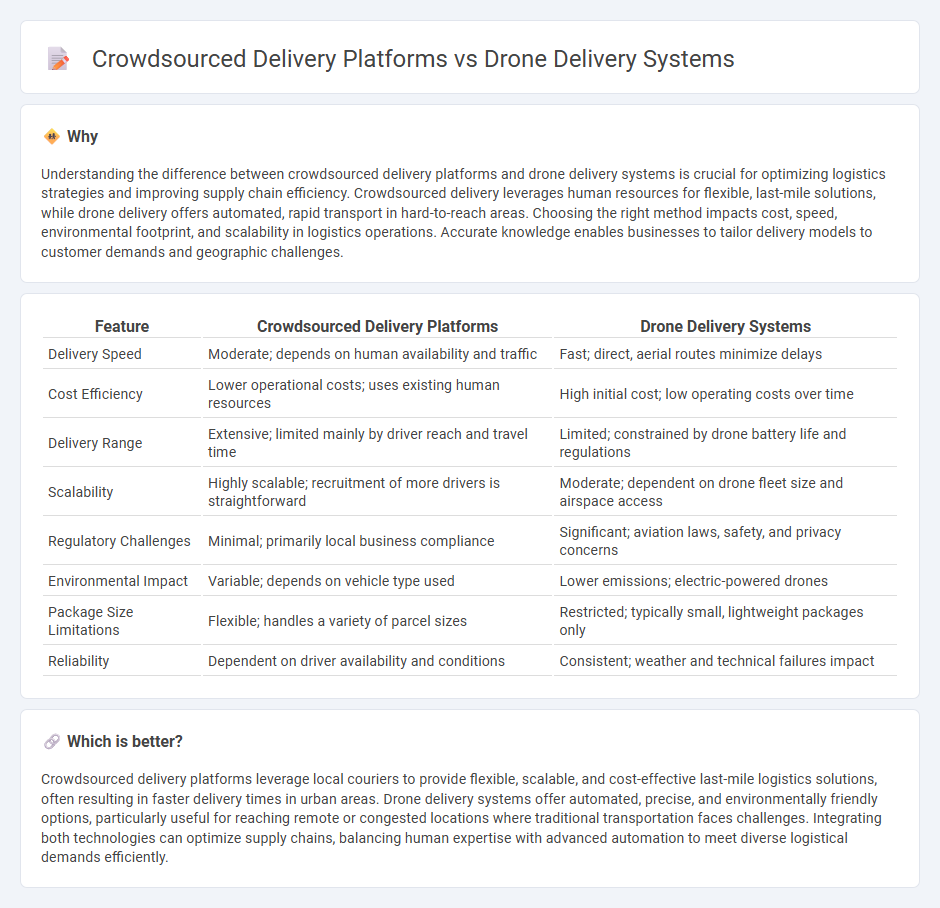
Crowdsourced delivery platforms leverage local individuals to fulfill last-mile logistics, enhancing flexibility and reducing delivery times through real-time human network coordination. Drone delivery systems utilize autonomous aerial vehicles equipped with GPS and sensors to achieve rapid, contactless transport of lightweight parcels, particularly effective in urban and remote areas. Explore the distinct advantages and operational frameworks of these innovative logistics solutions to determine the future of efficient delivery.
Why it is important
Understanding the difference between crowdsourced delivery platforms and drone delivery systems is crucial for optimizing logistics strategies and improving supply chain efficiency. Crowdsourced delivery leverages human resources for flexible, last-mile solutions, while drone delivery offers automated, rapid transport in hard-to-reach areas. Choosing the right method impacts cost, speed, environmental footprint, and scalability in logistics operations. Accurate knowledge enables businesses to tailor delivery models to customer demands and geographic challenges.
Comparison Table
| Feature | Crowdsourced Delivery Platforms | Drone Delivery Systems |
|---|---|---|
| Delivery Speed | Moderate; depends on human availability and traffic | Fast; direct, aerial routes minimize delays |
| Cost Efficiency | Lower operational costs; uses existing human resources | High initial cost; low operating costs over time |
| Delivery Range | Extensive; limited mainly by driver reach and travel time | Limited; constrained by drone battery life and regulations |
| Scalability | Highly scalable; recruitment of more drivers is straightforward | Moderate; dependent on drone fleet size and airspace access |
| Regulatory Challenges | Minimal; primarily local business compliance | Significant; aviation laws, safety, and privacy concerns |
| Environmental Impact | Variable; depends on vehicle type used | Lower emissions; electric-powered drones |
| Package Size Limitations | Flexible; handles a variety of parcel sizes | Restricted; typically small, lightweight packages only |
| Reliability | Dependent on driver availability and conditions | Consistent; weather and technical failures impact |
Which is better?
Crowdsourced delivery platforms leverage local couriers to provide flexible, scalable, and cost-effective last-mile logistics solutions, often resulting in faster delivery times in urban areas. Drone delivery systems offer automated, precise, and environmentally friendly options, particularly useful for reaching remote or congested locations where traditional transportation faces challenges. Integrating both technologies can optimize supply chains, balancing human expertise with advanced automation to meet diverse logistical demands efficiently.
Connection
Crowdsourced delivery platforms leverage a decentralized network of independent drivers to optimize last-mile logistics, while drone delivery systems employ autonomous aerial vehicles for rapid and efficient parcel transport. Both methods aim to reduce delivery times and operational costs by utilizing innovative technology and real-time data integration. The convergence of these systems enhances urban logistics by combining human flexibility with drone speed and precision.
Key Terms
**Drone Delivery Systems:**
Drone delivery systems utilize unmanned aerial vehicles equipped with GPS and advanced sensors to provide fast, contactless shipping for medical supplies, e-commerce, and food delivery. These systems reduce delivery times significantly in urban and remote areas by bypassing traffic congestion and geographic barriers. Explore the latest innovations and challenges in drone delivery technology to understand its impact on the future of logistics.
Airspace Regulation
Drone delivery systems face stringent airspace regulations that mandate altitude limits, no-fly zones, and real-time tracking to ensure safety and prevent collisions. Crowdsourced delivery platforms must comply with ground-level transport regulations and often navigate local traffic laws and restrictions, creating fewer challenges in airspace management but requiring robust logistics coordination. Explore the evolving regulatory landscape shaping the future of both delivery methods.
Unmanned Aerial Vehicle (UAV)
Unmanned Aerial Vehicle (UAV) drone delivery systems offer rapid, automated parcel transport with precise GPS navigation and reduced human labor, enhancing efficiency in last-mile delivery logistics. Crowdsourced delivery platforms leverage a decentralized network of local couriers, providing flexible, scalable solutions but often face challenges in consistency and speed compared to UAVs. Explore the latest advancements and comparative benefits of drone delivery and crowdsourced systems to understand their impact on the future of urban logistics.
Source and External Links
Delivery drone - Wikipedia - Delivery drones are UAVs designed to transport packages like food, medicines, and mail using technologies such as powerful brushless DC motors, lithium-ion batteries, ground control systems for navigation, parachute recovery systems for safety, and recharging stations along delivery routes to maintain operations.
A2Z Drone Delivery | Advanced Drone Delivery Technology - A2Z Drone Delivery offers last-mile drone logistics with solutions including weatherproof AirDock charging stations for nonstop missions, and drones like the Longtail Cargo with a 5 kg payload and 20 km range optimized for autonomous, hands-free delivery.
What Is Drone Delivery? Is It the Future? | Built In - Drone delivery companies use GPS, AI, and sensors like LiDAR to autonomously deliver goods by lowering packages to specified locations with high precision, exemplified by companies like Manna in Ireland and Flytrex in the US, which demonstrate cost-effective and efficient last-mile deliveries.
 dowidth.com
dowidth.com